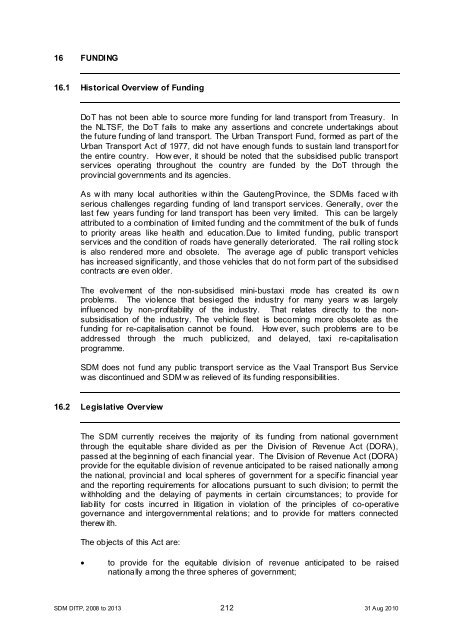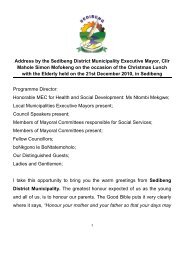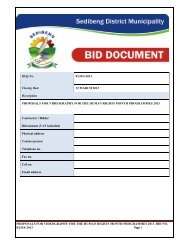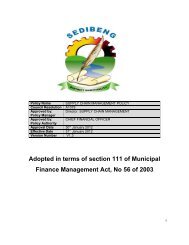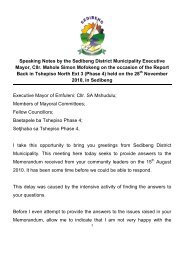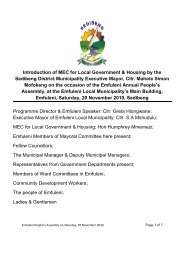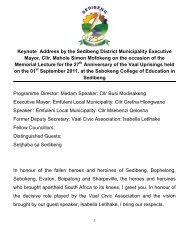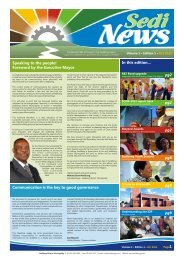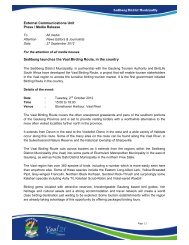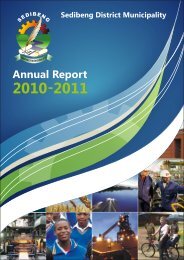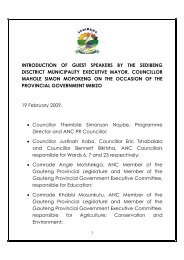Chapter 11 - Sedibeng District Municipality
Chapter 11 - Sedibeng District Municipality
Chapter 11 - Sedibeng District Municipality
You also want an ePaper? Increase the reach of your titles
YUMPU automatically turns print PDFs into web optimized ePapers that Google loves.
16 FUNDING<br />
16.1 Historical Overview of Funding<br />
DoT has not been able to source more funding for land transport from Treasury. In<br />
the NLTSF, the DoT fails to make any assertions and concrete undertakings about<br />
the future funding of land transport. The Urban Transport Fund, formed as part of the<br />
Urban Transport Act of 1977, did not have enough funds to sustain land transport for<br />
the entire country. How ever, it should be noted that the subsidised public transport<br />
services operating throughout the country are funded by the DoT through the<br />
provincial governments and its agencies.<br />
As w ith many local authorities w ithin the GautengProvince, the SDMis faced w ith<br />
serious challenges regarding funding of land transport services. Generally, over the<br />
last few years funding for land transport has been very limited. This can be largely<br />
attributed to a combination of limited funding and the commitment of the bulk of funds<br />
to priority areas like health and education.Due to limited funding, public transport<br />
services and the condition of roads have generally deteriorated. The rail rolling stoc k<br />
is also rendered more and obsolete. The average age of public transport vehicles<br />
has increased significantly, and those vehicles that do not form part of the subsidised<br />
contracts are even older.<br />
The evolvement of the non-subsidised mini-bustaxi mode has created its ow n<br />
problems. The violence that besieged the industry for many years w as largely<br />
influenced by non-profitability of the industry. That relates directly to the nonsubsidisation<br />
of the industry. The vehicle fleet is becoming more obsolete as the<br />
funding for re-capitalisation cannot be found. How ever, such problems are to be<br />
addressed through the much publicized, and delayed, taxi re-capitalisation<br />
programme.<br />
SDM does not fund any public transport service as the Vaal Transport Bus Service<br />
was discontinued and SDM w as relieved of its funding responsibilities.<br />
16.2 Legislative Overview<br />
The SDM currently receives the majority of its funding from national government<br />
through the equitable share divided as per the Division of Revenue Act (DORA),<br />
passed at the beginning of each financial year. The Division of Revenue Act (DORA)<br />
provide for the equitable division of revenue anticipated to be raised nationally among<br />
the national, provincial and local spheres of government for a specific financial year<br />
and the reporting requirements for allocations pursuant to such division; to permit the<br />
withholding and the delaying of payments in certain circumstances; to provide for<br />
liability for costs incurred in litigation in violation of the principles of co-operative<br />
governance and intergovernmental relations; and to provide for matters connected<br />
therew ith.<br />
The objects of this Act are:<br />
• to provide for the equitable division of revenue anticipated to be raised<br />
nationally among the three spheres of government;<br />
SDM DITP, 2008 to 2013 212 31 Aug 2010


